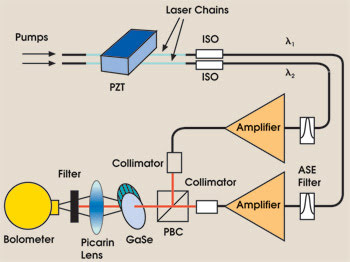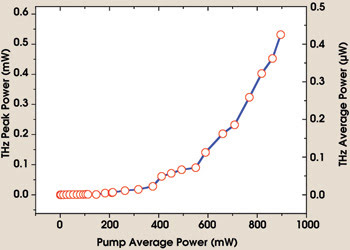
Two Q-Switched Fiber Lasers Generate Terahertz Radiation
Difference-frequency generation in GaSe produces terahertz output.
Breck Hitz
Between the optical and radio-frequency wavelengths, there is that mysterious gap of terahertz radiation that has been widely ignored in the development of practical applications of electromagnetic fields. One of the reasons for the lack of developments is the difficulty of generating and detecting radiation in this spectral range. Recently, scientists at NP Photonics Inc. in Tucson, Ariz., showed how terahertz radiation can be generated in a relatively compact, simple and robust device.
The scientists combined the outputs of two ~1550-nm Q-switched fiber lasers in a GaSe nonlinear crystal, where the difference in frequency between the two slightly offset laser wavelengths resulted in peak powers of hundreds of microwatts at a wavelength of 200 μm (Figure 1).

Figure 1. Terahertz radiation (200 μm) resulted from difference-frequency generation in GaSe between two Q-switched, single-mode fiber lasers at ~1550 nm. The Q-switched lasers operated at frequencies between 50 and 650 kHz, and their pulse duration increased from ~10 to ~70 ns with increasing repetition frequency. Images reprinted with permission of Optics Letters.
Each fiber laser was based on a short (2 cm) length of erbium-ytterbium-doped phosphate-glass fiber, with fiber Bragg gratings serving as the laser mirrors.
One of the gratings for each laser was fabricated in normal fiber, the other — the output coupler — in polarization-maintaining fiber. Each of the four gratings had an ~10-GHz reflectivity bandwidth, but because the output couplers were in polarization-maintaining fiber, they had different reflectivity peaks for each polarization, and the separation between the two was greater than 10 GHz. Thus, by temperature tuning the gratings, the scientists could force the laser to oscillate in only a single polarization. Moreover, by carefully offsetting the reflectivity peaks of the gratings, they allowed the laser to oscillate in only a single longitudinal mode.
To Q-switch the lasers, the scientists placed a piezoelectric transducer against the fiber, oriented at 45° to the polarization direction in the fiber. When the transducer pressed against the fiber, it induced a birefringence that coupled light out of the allowed polarization, thereby modulating the intracavity loss. To assure that the two lasers were synchronous, the scientists used the same piezoelectric transducer to press both fibers simultaneously (Figure 1).
A three-stage fiber-amplifier chain amplified the output of each fiber laser. The first two stages were fabricated from single-mode, silica-glass, polarization-maintaining fibers doped with only erbium for the first stage and Er-Yb for the second stage. The fiber lengths in the first and second stages were 3 m and 2 m, respectively. The final stage was a singlemode (15-μm core), Er/Yb-doped, polarization-maintaining phosphate fiber 10 cm long. A peak power in excess of 1 kW emerged from these amplifiers when the lasers were Q-switching at a 40-kHz rate.
The pulses from the two amplifiers were synchronous and of very nearly equal duration as they were combined in a beamsplitter and directed into the 15-mm-thick GaSe crystal. A terahertz-transmitting plastic lens (picarin) collected the terahertz radiation and focused it through a pump-blocking filter into a liquid-helium-cooled bolometer. The scientists measured peak terahertz powers of nearly 600 μW in the pulses, whose duration was in the tens of nanoseconds (Figure 2).

Figure 2. The terahertz radiation reached a peak power of ~500 μW, or an average power of ~400 nW.
By calculating the energy difference between photons from the two lasers, the scientists concluded that the terahertz wavelength they generated was 200 μm, and they subsequently confirmed this by measuring the wavelength directly with a metal-mesh etalon. They also calculated, according to optical parametric theory, that the bandwidth was approximately 35 MHz. Thus, the terahertz radiation was sufficiently narrow to be useful in identifying many low-pressure molecular gases, whose rotational linewidths can be less than 50 MHz.
Because the two lasers can be wavelength tuned by adjusting the temperatures of their fiber Bragg gratings, the terahertz radiation also can be tuned. In a demonstration experiment, the researchers generated 1110-μm radiation with a pair of fiber lasers tuned to slightly different wavelengths.
Optics Letters, April 15, 2007, pp. 949-951.
/Buyers_Guide/NP_Photonics_Inc/c10513